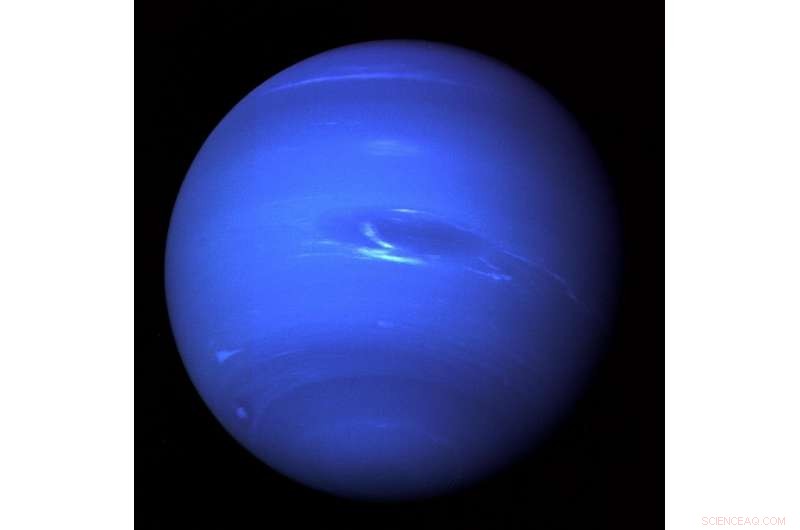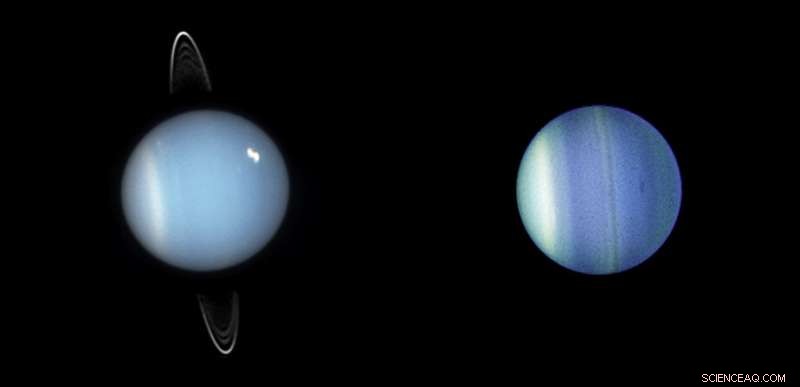
Wetenschap
IJsreuzen onderzoeken met NASA's Webb-telescoop

Deze Voyager 2-afbeelding van Neptunus toont een koude en donkere, door de wind opgejaagde wereld. In 1989, NASA's Voyager 2 werd het eerste en enige ruimtevaartuig dat de planeet Neptunus observeerde, passeren ongeveer 3, 000 mijl boven de noordpool van de planeet. Krediet:NASA/JPL-Caltech
Het verre Uranus en Neptunus - de ijsreuzen van ons zonnestelsel - zijn even mysterieus als ver weg. Kort na de lancering in 2021, NASA's James Webb Space Telescope zal dat veranderen door geheimen van de atmosferen van beide planeten te ontrafelen.
De koude en afgelegen reuzenplaneten Uranus en Neptunus worden de "ijsreuzen" genoemd omdat hun interieur qua samenstelling verschilt van Jupiter en Saturnus, die rijker zijn aan waterstof en helium, en staan bekend als de 'gasreuzen'. De ijsreuzen zijn ook veel kleiner dan hun gasachtige neven, tussen terrestrische planeten en de gasreuzen in. Ze vertegenwoordigen de minst onderzochte categorie planeten in ons zonnestelsel. Wetenschappers die Webb gebruiken om de circulatiepatronen te bestuderen, chemie en het weer van Uranus en Neptunus op een manier die alleen Webb kan.
"Het belangrijkste dat Webb kan doen, is heel, zeer moeilijk te bereiken vanuit een andere faciliteit is het in kaart brengen van hun atmosferische temperatuur en chemische structuur, " verklaarde de leider van de studies, Leigh Fletcher, een universitair hoofddocent planetaire wetenschap aan de Universiteit van Leicester in het Verenigd Koninkrijk. "We denken dat het weer en het klimaat van de ijsreuzen een fundamenteel ander karakter zullen hebben in vergelijking met de gasreuzen. Dat komt deels omdat ze zo ver weg zijn van de zon, ze zijn kleiner van formaat en draaien langzamer om hun assen, maar ook omdat het mengsel van gassen en de hoeveelheid atmosferische vermenging heel anders is in vergelijking met Jupiter en Saturnus."
Alle gassen in de bovenste atmosfeer van Uranus en Neptunus hebben unieke chemische vingerafdrukken die Webb kan detecteren. Cruciaal, Webb kan de ene chemische stof van de andere onderscheiden. Als deze chemicaliën worden geproduceerd door zonlicht dat in wisselwerking staat met de atmosfeer, of als ze van plaats naar plaats worden herverdeeld door grootschalige circulatiepatronen, Webb zal dat kunnen zien.
Deze studies zullen worden uitgevoerd door middel van een Guaranteed Time Observations (GTO)-programma van het zonnestelsel onder leiding van Heidi Hammel, een planetaire wetenschapper en Webb interdisciplinaire wetenschapper. Ze is ook Vice President for Science bij de Association of Universities for Research in Astronomy (AURA) in Washington, Het programma van D.C. Hammel zal de mogelijkheden van Webb demonstreren voor het observeren van objecten in het zonnestelsel en enkele van Webb's specifieke technieken toepassen voor objecten die helder zijn en/of in de lucht bewegen.
Uranus:de gekantelde planeet
In tegenstelling tot de andere planeten in ons zonnestelsel, Uranus - samen met zijn ringen en manen - ligt op zijn kant, draaien in een hoek van ongeveer 90 graden ten opzichte van het vlak van zijn baan. Hierdoor lijkt de planeet als een bal rond de zon te rollen. Die vreemde oriëntatie - die mogelijk het gevolg is van een gigantische botsing met een andere massieve protoplaneet in het begin van de vorming van het zonnestelsel - geeft aanleiding tot extreme seizoenen op Uranus.
Toen NASA's Voyager 2-ruimtevaartuig in 1986 langs Uranus vloog, één pool wees direct naar de zon. "Het maakt niet uit hoeveel Uranus zou draaien, " legde Hammel uit, "de ene helft stond de hele tijd in het volle zonlicht, en de andere helft was in totale duisternis. Het is het gekste wat je je kunt voorstellen."
Teleurstellend, Voyager 2 zag alleen een gladde planeet met een biljartbal bedekt met waas, met slechts een handvol wolken. But when Hubble viewed Uranus in the early 2000s, the planet had traveled a quarter of the way around in its orbit. Now the equator was pointed at the Sun, and the entire planet was illuminated over the course of a Uranian day.
"Theory told us nothing would change, " said Hammel, "But the reality was that Uranus started sprouting up all kinds of bright clouds, and a dark spot was discovered by Hubble. The clouds seemed to be changing dramatically in response to the immediate change in sunlight as the planet traveled around the Sun."

These Hubble Space Telescope images show the varied faces of Uranus. Aan je linker kant, Uranus in 2005 displays its ring system. The planet -- along with its rings and moons -- is tipped on its side, rotating at roughly a 90-degree angle from the plane of its orbit. In the Hubble close-up taken just one year later, Uranus reveals its banded structure and a mysterious dark storm. Krediet:NASA, ESA, and M. Showalter (SETI Institute); Right:NASA, ESA, L. Sromovsky and P. Fry (U. Wisconsin), H. Hammel (Space Science Institute), and K. Rages (SETI Institute)
As the planet continues its slow orbital trek, it will point its other pole at the Sun in 2028.
Webb will give insight into the powerful seasonal forces driving the formation of its clouds and weather, and how this is changing with time. It will help determine how energy flows and is transported through the Uranian atmosphere. Scientists want to watch Uranus throughout Webb's life, to build up a timeline of how the atmosphere responds to the extreme seasons. That will help them understand why this planet's atmosphere seems to go through periods of intense activity punctuated by moments of calm.
Neptune:A World of Supersonic Winds
Neptune is a dark, cold world, yet it is whipped by supersonic winds that can reach up 1, 500 miles per hour. More than 30 times as far from the Sun as Earth, Neptune is the only planet in our solar system not visible to the naked eye. Its existence was predicted by mathematics before its discovery in 1846. In 2011, Neptune completed its first 165-year orbit since its discovery.
Like Uranus, this ice giant's very deep atmosphere is made of a thick soup of water, ammoniak, hydrogen sulfide and methane over an unknown and inaccessible interior. The accessible upper layers of the atmosphere are made of hydrogen, helium and methane. As with Uranus, the methane gives Neptune its blue color, but some still-mysterious atmospheric chemistry makes Neptune's blue a bit more striking than that of Uranus.
"It's the same question here:How does energy flow and how is it transported through a planetary atmosphere?" explained Fletcher. "Maar in dit geval unlike Uranus, the planet has a strong internal heat source. That heat source generates some of the most powerful winds and the most short-lived atmospheric vortices and cloud features of anywhere in the solar system. If we look at Neptune from night to night, its face is always shifting and changing as these clouds are stretched and pulled and manipulated by the underlying wind field."
Following the 1989 Voyager 2 flyby of Neptune, scientists discovered a bright, hot vortex—a storm—at the planet's south pole. Because the temperature there is higher than everywhere else in the atmosphere, this region is likely associated with some unique chemistry. Webb's sensitivity will allow scientists to understand the unusual chemical environment within that polar vortex.
Just the Beginning
Fletcher advises to be prepared for seeing phenomena on Uranus and Neptune that are totally unlike what we've witnessed in the past. "Webb really has the capability to see the ice giants in a whole new light. But to understand the continual atmospheric processes that are shaping these giant planets, you really need more than just a couple of samples, " he said. "So we compare Jupiter to Saturn to Uranus to Neptune, en daarmee we build up a wider picture of how atmospheres work in general. This is the beginning of understanding how these worlds are changing with time."
Hammel added, "We now know of hundreds of exoplanets—planets around other stars—of the size of our local ice giants. Uranus and Neptune provide us ground truth for studies of these newly discovered worlds."
The James Webb Space Telescope will be the world's premier space science observatory when it launches in 2021. Webb will solve mysteries in our solar system, verder kijken naar verre werelden rond andere sterren, en onderzoek de mysterieuze structuren en oorsprong van ons universum en onze plaats daarin. Webb is an international program led by NASA with its partners, ESA (European Space Agency) en de Canadian Space Agency.
 Wetenschappers onderzoeken macrocyclische peptiden als nieuwe medicijnsjablonen
Wetenschappers onderzoeken macrocyclische peptiden als nieuwe medicijnsjablonen Het naderen van een ideale aminozuursynthese met behulp van waterstof
Het naderen van een ideale aminozuursynthese met behulp van waterstof Nieuwe sonde ontwikkeld om een gemeenschappelijk doelwit voor ontstekingsremmende medicijnen te detecteren
Nieuwe sonde ontwikkeld om een gemeenschappelijk doelwit voor ontstekingsremmende medicijnen te detecteren Op woestijnkever geïnspireerde magnetische demulgator ontwikkeld met uitstekende olie-in-water-emulsiescheidingsprestaties
Op woestijnkever geïnspireerde magnetische demulgator ontwikkeld met uitstekende olie-in-water-emulsiescheidingsprestaties Onderzoekers boeken belangrijke vooruitgang in de richting van productie van belangrijke biobrandstof
Onderzoekers boeken belangrijke vooruitgang in de richting van productie van belangrijke biobrandstof
Hoofdlijnen
- Soorten zenuwen in het menselijk lichaam
- In de mangoestenmaatschappij immigranten zijn een bonus - als ze tijd krijgen om zich te vestigen
- Convergente evolutie:wanneer een goed idee tussen soorten beweegt
- Fotograaf legt menselijk gezicht van bedreigde diersoorten vast
- Twee van 's werelds theesoorten uitgestorven in het wild volgens nieuw rapport
- Whodunnit, als Aussie-reptielen uitsterven:studie (update)
- BigH1 - de belangrijkste histon voor mannelijke vruchtbaarheid
- Hoe de verschillende soorten alveolaire cellen te identificeren
- Wat gebeurt er als een kind wordt geboren met een extra chromosoom in het 23e paar?
- Techniek biedt pad voor biofabricage van medicijnen tijdens ruimtevluchten

- Primitieve atmosfeer ontdekt rond Warm Neptunus

- NASA werpt een nieuwe kijk op het zoeken naar leven buiten de aarde

- De geschiedenis van de aarde gebruiken om de zoektocht naar leven op exoplaneten te informeren

- Een waterstofrijke, passieve melkweg

 Eerste bewijs dat zeehonden microplastics kunnen consumeren via hun prooi
Eerste bewijs dat zeehonden microplastics kunnen consumeren via hun prooi Diamantcircuits ontwerpen voor extreme omgevingen
Diamantcircuits ontwerpen voor extreme omgevingen Vogelsnavel onthuld door laserbeeldvorming informeert vroege snavelfunctie en ontwikkeling
Vogelsnavel onthuld door laserbeeldvorming informeert vroege snavelfunctie en ontwikkeling Onderzoekers hergebruiken mislukt kankermedicijn in afdrukbare halfgeleider
Onderzoekers hergebruiken mislukt kankermedicijn in afdrukbare halfgeleider Russische filmploeg gaat op pad om eerste film in de ruimte te maken
Russische filmploeg gaat op pad om eerste film in de ruimte te maken Hoe een kristallijne spons watermoleculen afstoot
Hoe een kristallijne spons watermoleculen afstoot Vergelijking van het menselijk oog met een camera
Vergelijking van het menselijk oog met een camera Hoe een natuurlijk logboek te annuleren
Hoe een natuurlijk logboek te annuleren
- Elektronica
- Biologie
- Zonsverduistering
- Wiskunde
- Italian | Spanish | Portuguese | Swedish | German | Dutch | Norway | French | Danish |

-
Wetenschap © https://nl.scienceaq.com

